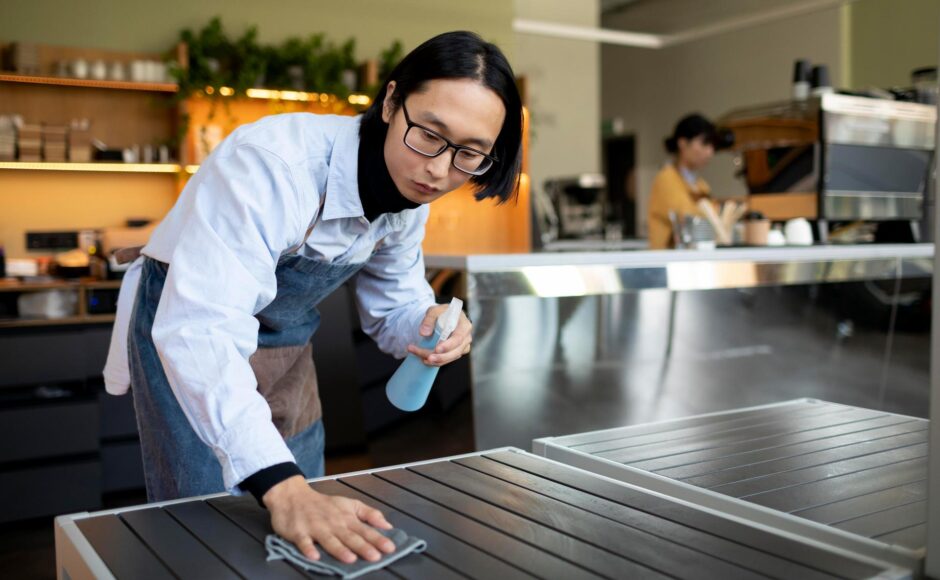A clean and efficient extraction system is critical for any commercial kitchen. From reducing fire hazards to improving air quality and ensuring regulatory compliance, regular kitchen extract cleaning isn’t just good practice; it’s essential.
Whether you run a restaurant, bar, café, catering business, or a large institutional kitchen, the extraction system plays a vital role in maintaining a safe and healthy cooking environment. Kitchen extracts are designed to remove heat, smoke, grease-laden vapours and airborne particles generated during food preparation. Over time, these byproducts build up within the hood, filters, ductwork, and fans, creating not only an unpleasant working environment but also a serious fire hazard.
A clean and efficient extraction system is critical for any commercial kitchen. In fact, grease accumulation in extraction systems is one of the leading causes of commercial kitchen fires. Beyond safety, a poorly maintained system can also affect the performance of ventilation equipment, reduce energy efficiency, and lead to violations of health and safety regulations. That’s why regular, professional extraction cleaning isn’t just a best practice, it’s a necessity.
If you’re unsure what the process involves or what to expect, this helpful step-by-step guide will walk you through the key stages of commercial kitchen extraction cleaning.
- Step 1 – Initial Inspection and Risk Assessment
Before any cleaning begins, an initial inspection needs to be conducted, which includes assessing the condition of the extractor hood, filters, ductwork, and fans. A risk assessment is then completed to identify any potential hazards and determine the level of contamination. This step is vital for planning the cleaning process and ensuring it meets legal standards like TR19 or equivalent local guidelines.
- Step 2 – Isolating the System
For safety and to avoid contamination, the extraction system is switched off and isolated. Gas and electrical supplies to surrounding appliances may also be turned off to protect both equipment and personnel. The area around the hood and ducts is then sealed and protected with coverings to prevent mess during the cleaning process.
- Step 3 – Removing and Cleaning Filters
The first part of the system to be cleaned is usually the grease filters. These are typically removable and are soaked in a heavy-duty degreasing solution to break down stubborn grease and grime. In some cases, filters may be replaced if they are too worn or damaged.
- Step 4 – Deep Cleaning the Canopy and Hood
Next, the technicians will focus on the canopy and interior surfaces of the extractor hood. Using specialised degreasers and scrubbing tools, they remove built-up grease deposits that can become fire hazards. Some cleaning services may use steam cleaning equipment for deeper, more effective results.
- Step 5 – Cleaning the Ductwork
The ductwork is one of the most critical and often most neglected parts of the system. Over time, grease builds up along the duct walls, posing a major fire risk. Cleaning the ductwork involves accessing various points along the duct route using inspection panels, where tools like rotary brush systems, air jets, or manual scrubbing are then used to thoroughly remove grease.
- Step 6 – Cleaning the Extraction Fan and Motor
The fan and motor are crucial for the performance of the entire system. If these components are clogged or greasy, airflow is reduced, which affects the kitchen environment and energy efficiency. The fan blades, casing, and motor housing are cleaned carefully to restore full functionality.
- Step 7 – Final Inspection and Certification
After cleaning is complete, a thorough inspection is carried out to ensure all components have been properly serviced. Most professionals will provide a post-cleaning report with photographic evidence and a certificate of compliance, which is important for insurance and health and safety audits.
Professional Kitchen Extract Cleaning Services
Regular extraction system cleaning is not only a legal requirement for commercial kitchens but also an investment in safety, performance, and hygiene. By following a structured cleaning process like this, you reduce fire risk, improve working conditions for kitchen staff, and maintain compliance with health and safety standards.
In order to ensure that your property’s kitchen extract system falls in line with the necessary regulations, laws and legislation, it is always advisable to use the services of certified professionals. These specialists are able to deliver a reliable, fast and cost-effective kitchen extract cleaning that makes sure your premises are safe and compliant.




